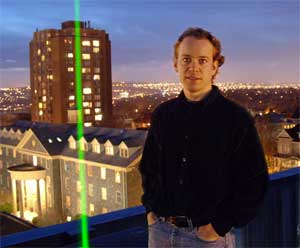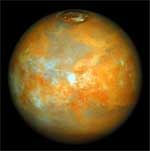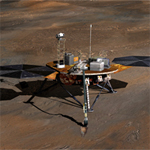 |
| Tom Duck with a lidar on the top of the Dunn building: "Since the beginning of time, people have looked to the stars and asked if there's anything else out there." (Abriel photo) |
The fundamental questionТ about whether there is (or was) life on Mars is closer to being answered with the imminent launch of the Phoenix Lander Mission.
This next U.S.-led scout mission to Mars will take along Canadian-built meteorological instruments that will provide the first daily weather measurements from the surface of another planet.
The Canadian weather station УТ including a lidar developed, built and run using the expertise of аТМгЦТСљКЯВЪПЊНБжБВЅ researchers У will blast off in early August as part of the Phoenix Lander Mission from Kennedy Space Centre in Cape Canaveral, Florida. The mission is being coordinated for NASA by the University of ArizonaУs Lunar and Planetary Laboratory. Senior Research Scientist Peter Smith serves as PhoenixУs principal investigator.
It will take the Phoenix spacecraft 10 months to reach the fourth planet from the sun, arriving on MarsУ polar region in late May of 2008. Landing on the surface can be a tricky business. PhoenixУs predecessor, the Mars Polar Lander, crashed and left behind a crater in 1999. If all goes according to plan this time, thrusters will cushion the descent and make for a soft landing.
УMars is our closest celestial neighbour. Since the beginning of time, people have looked to the stars and asked if thereУs anything else out there,т says Tom Duck, 36, co-investigator of the meteorological (or MET) weather station and the lidar specialist, in his office at аТМгЦТСљКЯВЪПЊНБжБВЅУs physics and atmospheric science department. The Canadian team also consists of members from York University and the University of Alberta, as well as members of the space engineering industry, namely MacDonald Detweiler and Associates.
УWeУre compelled to explore; itУs a part of human nature,т says Dr. Duck. УIn the past, we set off on sailing ships to find undiscovered countries. But now that we understand our planet better, Mars is the next step on this journey of exploration.т
PhoenixУs mission statement is: УFollow the waterт У water being the key ingredient to sustaining life. The Canadian weather instruments include a pressure sensor, three temperature sensors, located on a vertical mast, a wind speed indicator at the top of the mast and the lidar. Phoenix also comes equipped with a robotic arm for digging through soil into ice, a robotic arm camera, a surface stereo camera, a descent camera, a high-temperature oven, a mass spectrometer, a powerful atomic force microscope and a miniature wet chemistry laboratory.
The entire lander, about the size of a kitchen table, will be powered by two solar panels. One reason for landing on the Martian Arctic is, like CanadaУs northern region, it is exposed to sunlight 24 hours and 40 minutes each Martian day during the summer. Once the season changes, the area will be enveloped in darkness and the lander will eventually run out of power.
If water really does exist on Mars У either in the atmosphere, underground or frozen in ice at the surface У the implications for human exploration and eventual colonization of the planet would be far-reaching, says Victoria Hipkin, program scientist for planetary exploration with the Canadian Space Agency. Phoenix will collect data to help scientists understand Martian climate and weather, past and present.
УMars, at one time, was very Earth-like. For the first two billion years, Mars and Earth were very similar and thatУs when life originated. So it makes sense for us to want to look more closely at our closest celestial neighbour,т says Dr. Hipkin. The Canadian contribution for the Phoenix mission is $37 million out of a total mission cost of $411 million.
So what is lidar anyway? Lidar У the word is an acronym for Light Direction and Ranging У works like other remote sensing techniques such as sonar and radar. With lidar, a pulse of light (like sonarУs ping of sound) is directed straight up and any molecules, dust or clouds will cause the pulse to bounce back to the detector.
For the past few summers, a green laser beam of light has pulsed over the sky of Halifax from the roof of аТМгЦТСљКЯВЪПЊНБжБВЅУs Sir James Dunn Building. The lidar provides valuable insight into the atmospheric conditions above the city by measuring aerosols, clouds, water vapour and temperatures. In 2004, for example, the lidar detected smoke from forest fires in Alaska that blew across the continent and ended up over Nova Scotia, which Dr. Duck calls Уthe tailpipe of North America.т
This summer, as well as having a lidar on the Dunn Building, аТМгЦТСљКЯВЪПЊНБжБВЅ researchers
will be operating another one in the Arctic.
On Mars, a much smaller lidar, weighing just 6.5 kg, will detect the presence of dust, fog and ice clouds in the lower atmosphere. Fine dust У Уthink of a talcum powder storm,т says аТМгЦТСљКЯВЪПЊНБжБВЅУs Cameron Dickinson (BScУ98, PhDУ03) У is an important feature of the Martian atmosphere for its impact on the radiative balance in the atmosphere, which affects atmospheric temperature structure and dynamics. Dust also acts as a host for condensation in the formation of the water-ice clouds.
|
УIt is an analogous environment to Mars У very, very dusty. WeУll work through some of the fine details and make sure our measurements are as good as they can be,т says Dr. Duck. Meanwhile, theyУll have to contain their excitement as they wait for the Phoenix to make its dash through the Milky Way to Mars.
Once the Phoenix touches down, the аТМгЦТСљКЯВЪПЊНБжБВЅ scientists will remotely operate the lidar from mission control in Tucson, Arizona.
УWeУll talk to the spacecraft and it will send us back data,т explains Dr. Dickinson, 33. Commands will be transmitted to a satellite in orbit around Earth, which will then go to a satellite around Mars, and then to the lander.Т Т
УThe question IУm most often asked is, УWhat do you expect to find?Ут says Dr. Duck.Т УWell, thatУs not really why we do research. ItУs the unexpected thatУs so interesting. ItУs the unexpected where all the excitement comes from.
УWeУll see things we havenУt seen before. WeУre definitely going into uncharted territory.т


